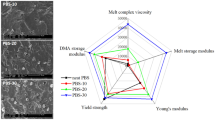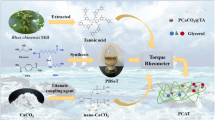Abstract
The functional blends of green materials are of great interest. In this study, we discovered a rare case of inherent miscibility in blends comprising a biodegradable polymer, poly(butylene adipate-co-butylene terephthalate) [P(BA-co-BT)], and a biocompatible natural polyphenol, catechin. According to the homogeneous phase morphology and single composition-dependent Tg (obtained from the microscopy and thermal analysis measurements), this work demonstrated that a natural polyphenol could be intimately mixed with a biodegradable copolyester showing a special aliphatic-aromatic backbone. The results of IR spectra and equilibrium melting point depression further indicated that it existed intermolecular interactions in the blends. We suggest that the molecular mixing between catechin and P(BA-co-BT) should be attributed to the preferable interactions of hydrogen bonding. Physical properties were also discussed in detail with studying the crystallization property of the blends. The nonisothermal crystallization of P(BA-co-BT) was also found to be influenced by the catechin in the blends. By the analysis results of the Mo model, it demonstrated that the rate dependent parameter, F(T), was increased as the catechin content was increased in the blends. In indicated that the rate of nonisothermal crystallization of P(BA-co-BT) was decreased with the addition of catechin in the blends.













Similar content being viewed by others
References
Hikima Y, Morikawa J, Hashimoto T (2013) Macromolecules 46:1582–1590
Barrett JSF, Abdala AA, Srienc F (2014) Macromolecules 47:3926–3941
Bagheri M, Motirasoul F (2012) e-Polymers. Article Number 087
Wang X, Zhuang Y, Dong L (2012) J Appl Polym Sci 126:1876–1884
Ojijo V, Ray SS, Sadiku R (2012) ACS Appl Mater Interfaces 4:6689–6700
Nimah H, Woo EM, Nurkhamidah S (2014) J Polym Res 21. doi:10.1007/s10965-013-0339-6
Su CC, Woo EM, Hsieh YT (2013) Phys Chem Chem Phys 15:2495–2506
Shieh YT, Twu YK, Su CC, Lin RH, Liu GL (2010) J Polym Sci B Polym Phys 48:983–989
Anderson S, Zhang J, Wolcott MP (2013) J Polym Environ 21:631–639
Kong XH, Qi H, Curtis JM (2014) J Appl Polym Sci 131. doi:10.1002/app.40579
Ishioka R, Kitakuni E, Ichikawa Y (2002) In: Doi Y, Steinbüchel A (eds) Polyesters III: applications and commercial products, vol 4. Biopolymer, Weinheim, Germany, pp 275–298
Gruber P, O’Brien M (2002) In: Doi Y, Steinbüchel A (eds) Polyesters III: applications and commercial products, vol 4. Biopolymer, Weinheim, Germany, pp 235–249
Aarar J, Gruys KJ (2002) In: Doi Y, Steinbüchel A (eds) Polyesters III: applications and commercial products, vol 4. Biopolymer, Weinheim, Germany, pp 53–90
Gan Z, Kuwabara K, Yamamoto M, Abe H, Doi Y (2004) Polym Degrad Stab 83:289–300
Cranston E, Kawada J, Raymond S, Morin FG, Marchessault RH (2003) Biomacromolecules 4:995–999
Kuwabara K, Gan Z, Nakamura T, Abe H, Doi Y (2002) Biomacromolecules 3:390–396
Zhao Y, Qiu Z (2015) RSC Adv 5:49216–49223
Lugito G, Woo EM (2015) Soft Matter 11:908–917
Zhang J, Fujizawa S, Isogai A, Hikima T, Takata M, Iwata T (2014) Polym Degrad Stab 110:529–536
Kuo SW, Chen CJ (2012) Macromolecules 45:2442–2452
Lee LT, Woo EM, Hou SS, Förster S (2006) Polymer 47:8350–8359
Papageorgiou GZ, Grigoriadou I, Andriotis E, Bikiaris DN, Panayiotou C (2013) Ind Eng Chem Res 52:11948–11955
Madhan B, Subramanian V, Rao JR, Nair BU, Ramasami T (2005) Int J Biol Macromol 37:47–53
Zhu B, Li J, He Y, Yoshie N, Inoue Y (2003) Macromol Biosci 3:684–693
Kuo SW, Chan SC, Chang FC (2002) Polymer 43:3653–3660
Gordon M, Taylor JS (1952) J Appl Chem 2:493–500
Kwei TK (1984) J Polym Sci Polym Lett Ed 22:307–313
Coleman MM, Graf JF, Painter PC (1991) Specific interactions and the miscibility of polymer blends. Technomic, Lancaster University
Hoffman JD, Weeks JJ (1962) J Res Natl Bur Standards A 66:13–28
Zhang H, Bhagwagar DE, Graf JF, Painter PC, Coleman MM (1994) Polymer 35:5379–5397
Lee LT, Woo EM (2006) J Polym Sci B Polym Phys 44:1339–1350
Liu X, Wu Q (2002) Eur Poly J 38:1383–1389
Auliawan A, Woo EM (2012) J Appl Polym Sci 125:E444–E458
Acknowledgments
This work has been financially supported by basic research grants of MOST 104-2221-E-035-079- and MOST 105-2221-E-035-091- from Taiwan’s Ministry of Science and Technology (MOST), to which the authors express their gratitude. The authors appreciate the Precision Instrument Support Center of Feng Chia University in helping the SEM measurements of our works.
Author information
Authors and Affiliations
Corresponding author
Rights and permissions
About this article
Cite this article
Lee, LT., Wu, MC., Yang, CT. et al. Studies of inherent mixing and physical properties for green polymer blends comprising natural polyphenol and biodegradable polymer with aliphatic-aromatic backbone. J Polym Res 23, 255 (2016). https://doi.org/10.1007/s10965-016-1153-8
Received:
Accepted:
Published:
DOI: https://doi.org/10.1007/s10965-016-1153-8




